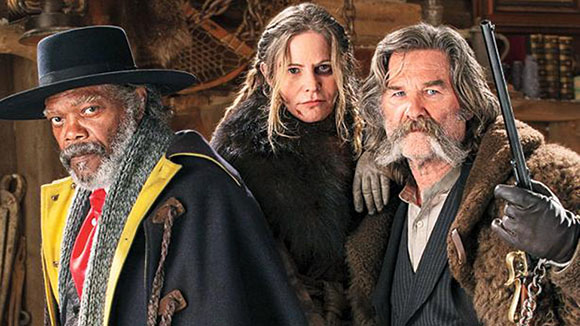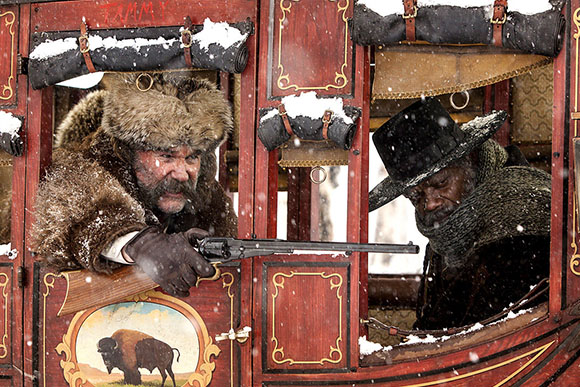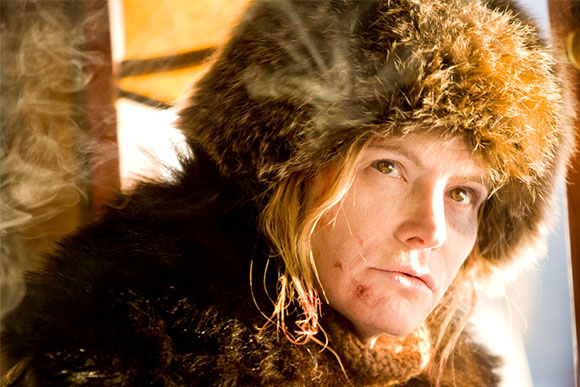
TN: Here it is. After all the hullaballoo of the script leak, the police boycotts, the reports of disastrous 70mm screenings, the Cinerama Dome incident, and the inevitable leak of the entire film, here it is. And it’s about as good as you might expect from Tarantino, who is as much a movie star as he is a writer or director. This may look like an ensemble piece, but make no mistake — Tarantino’s the star. And he knows it.
Nearly everyone else (Jackson, Goggins, Roth, Madsen, et al.) plays an asshole, cooped up in a Wyoming mountain cabin to wait out a terrible blizzard. The lynchpin is Daisy Domergue (Jennifer Jason Leigh), who is on her way to the gallows, courtesy of bounty hunter John Ruth (Kurt Russell). Before long, it becomes evident that something is very wrong — the owners of the cabin are nowhere to be found, and minor signs of a struggle begin to appear. Who are these people in the cabin? What grudges do they hold? Can any of them be trusted?
DD: Though this is another western for Tarantino, it couldn’t be further from the more superheroic Django Unchained. The Hateful Eight is a Tarantino suspense play, and while things take their slow and steady time to get us into the meat of the mystery (this is a film that’s pacing immensely benefits from having an intermission), it’s all for a good cause. Spending as much time as possible with our cast of characters makes the second half and its whodunit structure work like gangbusters.
You hit the nail on the head: the core of the narrative is essentially a stage play — one seen through Ultra Panavision 70 — but a stage play nonetheless. You might think the super-wide 2.76:1 aspect ratio (too wide to properly fit the screens at most cineplexes, including the one where we saw it) would work against the film’s claustrophobic nature, but it really works in the film’s favor. It’s not just beautiful; It has the effect of heightening the film’s suspense. Every suspicious squint, every tightening of gloved fingers on a pistol, every rack of the focus is amplified. QT’s love of split diopter (allowing for two distinct areas of focus in a single shot) has never been more beautiful or fitting than it is here, in the super-wide frame.

We had previously talked about how great spectacle cinema is when it uses that extended frame to focus on characters instead of action, and The Hateful Eight might be the Rosetta Stone of such a belief. There’s a strong intimacy and a distrusting distance that comes across during particular moments thanks to the Panavision format. But, the pure beauty isn’t lost on me. The opening shots are breathtaking, but they also allow Tarantino to lull the audience into a sense of claustrophobia once the film’s story starts off proper.
And the flick takes its sweet time to start off proper. The first couple of chapters (a hallmark of Tarantino) are dedicated to the long, chatty stagecoach ride that introduces us to five central cast members. It’s the film’s weakest section in terms of pacing, with lots of repetitive dialogue and scenery chewing by Russell and Walton Goggins. Stuff like this is why I just can’t agree with those who dismiss or disagree with the idea that Tarantino is indulgent, or that his indulgence works against him. C’mon — the only real reason that these characters talk so damn much is that Quentin Tarantino loves to hear himself talk. Now, I do believe there’s a level of narcissism inherent to all creative writing, but Tarantino actually narrates the film at one point (to undeniably humorous effect). You can read it in his screenplays, and you can see and hear it in every scene of The Hateful Eight.
Indulgence has always been Tarantino’s game, seeing as he basically makes movies to indulge his own deep-seated dorkery for particular film genres and stylings, but never has Tarantino been more self-servicing than The Hateful Eight. Not only is he shooting a film in Glorious 70MM, but this has the most focus on straight dialogue than anything Tarantino has done before. I don’t see this as a slight; this is Tarantino’s third epic film (the others being Kill Bill and Inglourious Basterds) and he’s perfected this bizarre balance between refinement and excess that I think will come to define the back half of his directorial output.
Something that really represents that balance between refinement and excess is the film’s score, which has quickly become one of my favorites of the year. It’s actually one of Morricone’s more classical scores, much more classical than his guitar-laden spaghetti western scores, but much grander than this score for The Thing. It’s thrilling, almost frightening to hear a brand new score in a Tarantino film. It’s a feeling of uncharted territory, and it helps that Morricone’s new compositions are actually pretty frightening. The film’s three-minute overture is an essential experience; not a sweeping western fanfare or a showcase of the film’s musical themes, but a bone-chilling repeating motif. And it sure as hell sets the stage better than some dumb commercial ever could.
You’re much more learned in the field of music than I, but I must admit that the overture music sent shivers through my body. The score never ceases to disappoint, even when Tarantino does his usual thing and plucks a cue directly from John Carpenter’s The Thing. Morricone’s score is possibly the closest we’ll ever get to Tarantino utilizing a soundtrack for horror, and I couldn’t be happier. I think this may also be the Tarantino film with the fewest needle drops, but I won’t swear to that. The songs we got were very good, but nothing is beating that overture.

You and I tend to see (and hear) horror in just about everything, and that’s because we’re weirdo obsessives. But you don’t have to be an obsessive to find the horror in The Hateful Eight. The film explodes into pseudo-splatter; albeit not as manic and Peckinpah-flavored as the zany blood squibs in Django Unchained. There are fewer bullets fired in this film than in Django, but the context here gives each impact much more weight. There’s more shock, more emotional impact. I don’t want to spoil the moment, but there are three moments of — ahem — explosive, projectile horror that actually made me groan involuntarily in the theater. Tarantino paints that cabin redder than Evil Dead II.
I mentioned this to you on our way out of the theater, and I think it bears repeating: The Hateful Eight is Tarantino’s meanest movie to date. Practically every lead character is despicable in one way or another, and the violence in this movie (while being viscerally fun for twisted fucks like us) is almost uniformly harsh and unnecessarily cruel. There’s no cartoonish neck-fountain like in Kill Bill or over-the-top gunshot blowback like Miss Laura’s death in Django Unchained. You feel the weight of every pistol-whip to Daisy’s head and the pain of every bullet.
And that’s something I really want to talk about at length: the violence and horrible treatment Daisy is subjected to throughout the film and what Tarantino is trying to say through it. Ostensibly, she is the villain of the piece, but she’s an intelligent, cunning, and talented antagonist. I can’t properly discuss all the horrors that befall Daisy without getting into spoilers, but suffice to say that she is beaten, bloodied (often times the blood she’s drenched in isn’t her own), and ultimately she is the person that unifies two characters who were practically enemies. There’s something darkly satisfying and complex about Tarantino saying that the only way two people (or groups or ideologies or whatever) can become allies or even friends is to find someone to mutually hate. Hatred (particularly towards race) is something this film is appropriately pondering, and it’s a thorny subject that I can’t help but admire.
There’s no easy message to take away from this one. It’s one of Tarantino’s messier films, emotionally or morally speaking. Samuel L. Jackson’s Major Warren is perhaps the easiest character to identify with, but he’s got more than a touch of evil in him. But is he righteous? I feel an extraordinary cynicism in this film. Deceit, hatred, and violence are the ties that bind all of the central characters. Circumstance and remarkable coincidence pushed them out of white hell and into a cage. Is it a microcosm; a distillation of the current sociopolitical climate? We know Tarantino’s got this stuff on his mind. But, if we’re just trying to figure out if this is a good movie, it’s more important that the film feel true to itself. And through all its gleeful and terrible violence, hateful language and bloated indulgence, The Hateful Eight feels very true to itself, and to its creator. And I suppose, while he’s making movies, that we should embrace that Tarantino will always swing for the fences. That’s the only way to make movies as interesting and as good as The Hateful Eight.
Travis’ Rating: 




Out of a Possible 5 Stars
Drew’s Rating: 




Out of a Possible 5 Stars